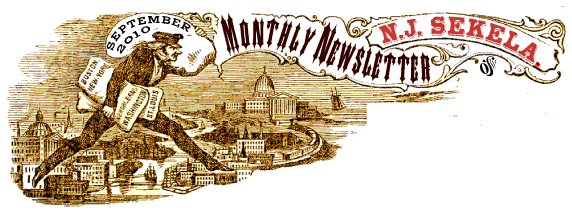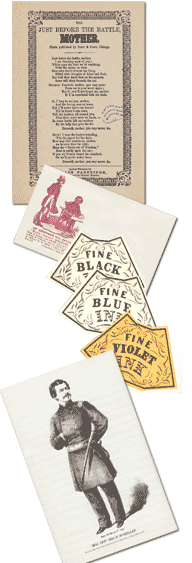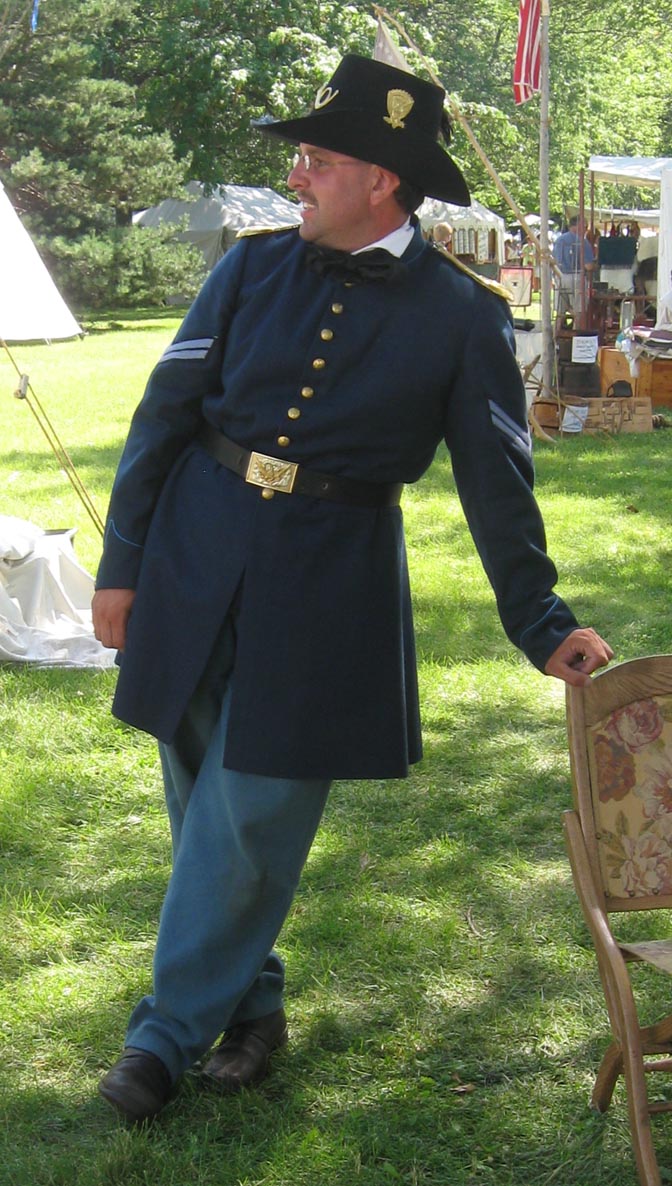
The Brooks' are in!!
This took a while, but I am very satisfied with the results. We weren't satisfied to base it only on one original; we examined several. We put all of the details of the originals into the reproduction.
This item still remains as handy as it did in the 1860's.
Stay tuned for the Hathaway kit coming soon!

Customer of the Month
Brad Wohlman
Brad first learned about civil war reenactment in 2005 when he visited St Paul Minnesota and saw a group at Ft Sistine. After some investigating, he found out there was a group in the his local area (WAAAAAAAAAAAAY out west!). When he went to visit a Lincoln's display at the Old Courthouse Museum in Sioux Falls, he was able to connect with the Sioux Falls members who invited me to a meeting and the rest is history.
Brad recalls that his most memorable event was when he attended a Gettysburg event in June of 2007. As a Minnesota native and he was very excited to find out that the First Minnesota Volunteers were going to be part of the portrayal. He walked the battlefield where the original unit fought and gave the ultimate sacrifice. Doing the four mile march gave him an appreciation for the strength of the original soldiers.
Portraying the civil war area gives him a chance to experience history and to follow where the Minnesota troops where. He also enjoys traveling and sharing a common friendship with others from across the country.
New P. M'Dermott offerings!
 P. M'Dermott continues to add to their line of products with the addition of the songsheet, Just Before the Battle Mother, Comic envelope, umbrella inkwell labels for different colored inks and McClellan note-paper.
P. M'Dermott continues to add to their line of products with the addition of the songsheet, Just Before the Battle Mother, Comic envelope, umbrella inkwell labels for different colored inks and McClellan note-paper.
Kevin "Pat" M'Dermott draws upon an almost half century of experience in the living history field, ranging from 17th century to late 19th. His perspective on mid-19th century life takes with it a senstivity to the material culture, where you begin to USE the items to better understand and interpret the period.

Friends: Mr. Sekela has kindly asked me to write a few words from time to time with respect to my thoughts on the philosophy and practice of living history. Never having been short of either thoughts or words it will be easy, for my part, to oblige him; how much value the results possess must be decided, however, by you. I should be delighted if these occasional pieces, the fruit of some 35 years of thought, were to become the starting points for further discussion and hope to see what you think in the threads of the N.J. Sekela Forum at http://www.njsekela.com/forum/.
—Patrick M’Dermott
Internal Authenticity, first installment:
LOVING TOO MUCH
If you are reading these words you are probably one of those reenactors who can rattle off Federal blouse contractors or the various Confederate depots and then go on to list the major and minor variations between their products…or you want to be. There’s absolutely nothing wrong with this; in the immortal words of Emil Faber, “Knowledge is Good!” But it is all too easy to fall under the spell of this kind of abstract knowledge and forget that the soldiers for whom those items were made couldn’t have cared less how their blouses or trowsers were seamed (as long as they held together!); they didn’t care about the details of armscyes or lining materials, as long as they had clothing that fit and stood up to hard use.
To Mr. Freud, a cigar was sometimes “just a cigar;” but to “the Boys,” a blouse was always just a blouse…the thing that made it different was that it was “soldier clothes” rather than “citizen clothes,” and fatigue rather than dress uniform. To the Boys, our beloved (and expensive) uniform and kit items were completely unremarkable, work-a-day, clothes.
Back when I started reenacting—many many moons ago!—there were some lads who would appear at an event with their uniforms in suit bags, fresh from the cleaners. I haven’t taken the field for a decade now, so I can’t say whether this continues: but I can say it was wrong with regards to external authenticity (the clothes smelled of cleaning fluid and were entirely too clean for anything except dress parade in a fort) and—far more importantly—in what was revealed about the internal authenticity of the uniforms’ owners.
In this man’s opinion, those uniforms were fetish objects: something very special, to be lovingly cared for and used only on certain occasions in certain ways. To their owners, it seemed, they were mostly the sum total of a lot of drooling, a lot of saving, and perhaps a bit of conspicuous consumption—the feeling that owning “the good stuff” automatically made you one of the elite.
Friends: it ain’t so. If you are interested in being more than a mannequin in a museum display, that which is between your ears is what matters. Although we can never actually become mid-19th century people, we must try to become as much like them as possible if we want to have the fullness of the time-traveling experience ourselves and therefore be able to convey it to those who visit our encampments and museums. One way to start is to de-fetishize your clothing and kit.
During my time afield I was relatively poor—and preferred to spend what money I did have on 19th rather than 20th century clothing. My greatcoat was my winter overcoat; my bummer cap was my cap; I frequently wore my blouse, vests, and shirts on a day to day basis. I was lucky enough to be able to do this; I had indulgent employers—you may not be so lucky. But we can all find times and places to use our period clothes in “normal” situations: wear your fatigue cap when mowing the lawn, or your blouse when raking leaves. Take the word of an old campaigner: the change in your relationship to your period belongings will surprise you.
“FINIAN.”
Abel Putnam Button Update.
check it out!
In an effort to be as thorough as possible, I felt that the story of the patent went far beyond the standard "poncho button" presentation of the hobby. It is not only about the artifact, but also about the inventor.
to be as thorough as possible, I felt that the story of the patent went far beyond the standard "poncho button" presentation of the hobby. It is not only about the artifact, but also about the inventor.
This approach has yielded a great return. Upon googling her ancestor, one of descendants of Abel Putnam, found my site. She was not only grateful for the information that I put about him, but willingly shared the enclosed image of the patentee.
I find this particularly satisfying as it goes beyond an artifact, or another reproduction item. The history behind the item connects the artifact to living people.
New and upcoming projects!
Patterns
After extended deliberation, we have decided to throw our hat in the ring and offer a line of patterns. We are different from County Cloth, Gala Rock and the others because of our capacity to offer the patterns in digital format. Not only are digital patterns more accurate, up to the .005 of an inch, they can be easily altered to your body type.
What really sets these apart from County Cloth, Gala Rock and others, is that you are able to get these patterns in hand the same day, and in as little as 20 minutes after ordering. Because they are in a digital format, they can be sent to your local Staples or Fedex Kinkos, and they can print it out while you wait.
New glassware items

Glassware are items that are commonly dug in known Civil War campsites and battlefields, and almost never have been offered as reproductions. Just about every relic book has at least ONE example of the umbrella inkwell, yet this is something completely absent from the living history arena.
Our latest additions to the glassware line are the umbrella inkwell and the hair oil bottle, but we will be adding many more items in the very near future. These will include additional patent fuit jars, sauce and liquor bottles. Again, we are keeping the pricing so that there isn't the same fear of breakage that accompanies using irreplaceable originals.
Ladies Corsets
Although our offerings for the historical interpreter has been geared more towards menswear, the majority of my career in the apparel industry has been in the ladies' markeplace. As a result, I wanted to draw from this experience to offer some of the more difficult items to produce. The overwhelming interest seems to be in the corset.
We will be producing a corset based upon an original in the Juanita Leisch-Jensen collection. The original contained steel boning and busk, but surprisingly sections of rattan reed, like that found in the Federal Forage Cap. Stay tuned!
Alpaca Serge
We have heard a few vendors claiming to offer or having "found" a retail source for alpaca serge. The combination of alpaca with a celluose fiber in a fashion setting is antithetical to trends of today's apparel industry.
Several years ago, we had tried to have this fabric produced, only to find that the minimum for the raw fiber was $50,000. Through continued perserverence, and through my contacts in New York, I was not only able to find a reasonable amount of the CORRECT alpace fiber, but also a spinner and weaver to complete the project.
We are not just throwing together two fibers and hoping for the best. We started with samples of original alpaca and had it analyzed by the spinning company's lab in europe. Upon getting the specifics of the original fabric, we were able to book time with a mill in late fall.
This is the first time that this has been offered to the hobby and we are excited to do so. This is a staple fabric, being found in both military and civilian garments.
Field Agents Wanted!
We are always looking to add to our staff, and moreso with the additional time periods we cover. If you are intersted, or know of someone how might be, send them along!

